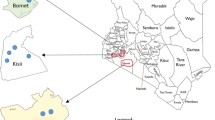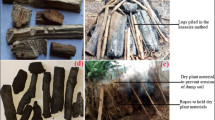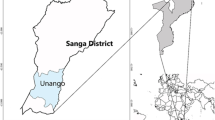Abstract
Energy for household use is expensive and is thus less available to communities, especially in developing countries. In Kenyan rural households, the primary source of domestic cooking fuel is either locally available firewood, charcoal produced through gradual pyrolysis of these firewood, or biomass briquettes. Nonetheless, there have been minimal investigations that characterize and compare typical firewood species and the associated charcoal fuels in terms of moisture content, calorific values, and their relationships. Consequently, this study sought to ascertain the moisture content, ultimate analysis, and calorific values of Grevillea robusta, Arundinaria alpina, Eucalyptus globulus, Azadirachta indica, Gliricidia sepium, Adansonia digitata L., Cyprus, and Acacia auriculiformis wood fuels, and the corresponding charcoal and briquettes in Bomet, Narok, Taita Taveta, and Mombasa Counties. The bomb calorimeter method was used to determine the calorific values while the elemental analyzer was used to determine carbon, nitrogen, sulfur, and oxygen levels in the fuel. Moisture content of the wood fuels ranged from 2.36 ± 0.01% to 4.93 ± 0.02%, briquettes from 2.57 ± 0.02–3.22 ± 0.07%, and charcoal, from 2.02 ± 0.01–2.73 ± 0.05%. Briquette samples had the highest carbon composition of 74.69% and 75.77%, followed by charcoal and firewood, respectively. It was found that firewood fuels had a higher oxygen content (39.47–49.96%) than the other fuels (21.71–36.54%). In elemental analysis, the majority of the samples had sulfur and nitrogen content of less than 1% while the hydrogen content ranged from 1.26% to 6.04%. The calorific values of the solid fuels ranged between 13.13 ± 0.11 MJ/kg and 32.71 ± 0.19 MJ/kg. The findings suggest a relationship between moisture content and calorific values since low moisture content fuels had high calorific values which could be attributed to the increased value of the carbon-to-oxygen (C/O) proportion (ranging from 0.94 to 3.36). Based on the calorific value analysis, the order of fuel strength was found to be; charcoal > firewood > briquettes. As a result, the study's findings demonstrate that the proximate, ultimate, and calorific values analyses of solid fuel play a vital role in determining the best fuel with higher energy values in accordance with the International Energy Agency's (IEA) requirements.











Similar content being viewed by others
Data Availability
Data will be made available on request.
References
Gielen D, Boshell F, Saygin D, Bazilian MD, Wagner N, Gorini R (2019) The role of renewable energy in the global energy transformation. Energ Strat Rev 24:38–50. https://doi.org/10.1016/j.esr.2019.01.006
G. Pełka, W. Luboń, and P. Pachytel, "Analysis of the efficiency of a solid fuel boiler depending on the choice of combusted fuel," in E3S Web of Conferences, 2020, p. 02003. https://doi.org/10.1051/e3sconf/202015402003
Pietrzak MB, Igliński B, Kujawski W, Iwański P (2021) Energy transition in Poland—Assessment of the renewable energy sector. Energies 14:2046. https://doi.org/10.3390/en14082046
Yan P, Xiao C, Xu L, Yu G, Li A, Piao S et al (2020) Biomass energy in China’s terrestrial ecosystems: Insights into the nation’s sustainable energy supply. Renew Sustain Energy Rev 127:109857. https://doi.org/10.1016/j.rser.2020.109857
Benti NE, Gurmesa GS, Argaw T, Aneseyee AB, Gunta S, Kassahun GB et al (2021) The current status, challenges and prospects of using biomass energy in Ethiopia. Biotechnol Biofuels 14:1–24. https://doi.org/10.1186/s13068-021-02060-3
M. Lubwama, V. A. Yiga, I. Ssempijja, and H. N. Lubwama, "Thermal and mechanical characteristics of local firewood species and resulting charcoal produced by slow pyrolysis," Biomass Conversion and Biorefinery, pp. 1–16, 2021. https://doi.org/10.1007/s13399-021-01840-z
Gabisa EW, Gheewala SH (2018) Potential of bio-energy production in Ethiopia based on available biomass residues. Biomass Bioenerg 111:77–87. https://doi.org/10.1016/j.biombioe.2018.02.009
Osano A, Maghanga J, Munyeza C, Chaka B, Olal W, Forbes P (2020) Insights into household fuel use in Kenyan communities. Sustain Cities Soc 55:102039. https://doi.org/10.1016/j.scs.2020.102039
Awulu J, Omale P, Ameh J (2018) Comparative analysis of calorific values of selected agricultural wastes. Niger J Technol 37:1141–1146. https://doi.org/10.4314/njt.v37i4.38
Martínez SH, Koberle A, Rochedo P, Schaeffer R, Lucena A, Szklo A et al (2015) Possible energy futures for Brazil and Latin America in conservative and stringent mitigation pathways up to 2050. Technol Forecast Soc Chang 98:186–210. https://doi.org/10.1016/j.techfore.2015.05.006
Rotich B, Ojwang D (2021) Trends and drivers of forest cover change in the Cherangany hills forest ecosystem, western Kenya. Global Ecology and Conservation 30:e01755
Bahru T, Kidane B, Tolessa A (2021) Prioritization and selection of high fuelwood producing plant species at Boset District, Central Ethiopia: an ethnobotanical approach. J Ethnobiol Ethnomed 17:1–15. https://doi.org/10.1186/s13002-021-00474-9
Sanlisoy A, Melez H, Carpinlioglu MO (2017) Characteristics of the solid fuels for the plasma gasification. Energy Procedia 141:282–286. https://doi.org/10.1016/j.egypro.2017.11.106
Álvarez-Álvarez P, Pizarro C, Barrio-Anta M, Cámara-Obregón A, Bueno JLM, Álvarez A et al (2018) Evaluation of tree species for biomass energy production in Northwest Spain. Forests 9:160. https://doi.org/10.3390/f9040160
Akolgo GA, Awafo EA, Essandoh EO, Owusu PA, Uba F, Adu-Poku KA (2021) Assessment of the potential of charred briquettes of sawdust, rice and coconut husks: Using water boiling and user acceptability tests. Scientific African 12:e00789. https://doi.org/10.1016/j.sciaf.2021.e00789
Trubetskaya A, Lin C, Ovadnevaite J, Ceburnis D, O’Dowd C, Leahy JJ et al (2021) Study of Emissions from Domestic Solid-Fuel Stove Combustion in Ireland. Energy Fuels 35:4966–4978. https://doi.org/10.1021/acs.energyfuels.0c04148
S. Haszeldine, A. Cavanagh, V. Scott, S. Sohi, O. Masek, and P. Renforth, Greenhouse Gas Removal Technologies: Approaches and Implementation Pathways in Scotland: University of Edinburgh & Heriot Watt University 2019 on behalf of ClimateXChange, 2019. https://www.climatexchange.org.uk/media/3749/greenhouse-gas-removal-technologies.pdf
Takase M, Kipkoech R, Essandoh PK (2021) A comprehensive review of energy scenario and sustainable energy in Kenya. Fuel Communications 7:100015. https://doi.org/10.1016/j.jfueco.2021.100015
V. R. Nalule, "Transitioning to a low carbon economy: Is Africa ready to bid farewell to fossil fuels?," in The Palgrave Handbook of Managing Fossil Fuels and Energy Transitions, G. Wood and K. Baker, Eds., ed Cham: Springer International Publishing, 2020, pp. 261–286. https://doi.org/10.1007/978-3-030-28076-5_10
J. O. Bosire, A. M. Osano, J. K. Maghanga, and P. B. C. Forbes, "Assessment of Local Domestic Solid Fuel Sources: A Kenyan Case Study in Kisii, Bomet and Narok Counties," Chemistry Africa, 2023/02/20 2023. https://doi.org/10.1007/s42250-023-00601-x
F. Dalla Longa and B. van der Zwaan, "Do Kenya’s climate change mitigation ambitions necessitate large-scale renewable energy deployment and dedicated low-carbon energy policy?," Renewable Energy, vol. 113, pp. 1559–1568, 2017. https://doi.org/10.1016/j.renene.2017.06.026
M. Ramesh, C. Deepa, U. S. Aswin, H. Eashwar, B. Mahadevan, and D. Murugan, "Effect of Alkalization on Mechanical and Moisture Absorption Properties of Azadirachta indica (Neem Tree) Fiber Reinforced Green Composites," Transactions of the Indian Institute of Metals, vol. 70, pp. 187–199, 2017/01/01 2017. https://doi.org/10.1007/s12666-016-0874-z
S. Sarkar, R. P. Singh, and G. Bhattacharya, "Exploring the role of Azadirachta indica (neem) and its active compounds in the regulation of biological pathways: an update on molecular approach," 3 Biotech, vol. 11, p. 178, 2021. https://doi.org/10.1007/s13205-021-02745-4
Atapattu J, Pushpakumara G, Rupasinghe D, Senarathne S, Raveendra T (2017) Potential of Gliricidia sepium as a fuelwood species for sustainable energy generation in Sri Lanka. Agricultural Research Journal 54:34–39. https://doi.org/10.5958/2395-146X.2017.00006.0
A. T. Oyelere and A. O. Oluwadare, "Studies on Physical, Thermal and Chemical Properties of Wood Gliricidia sepium for Potential Bioenergy Production," International Journal of Biomass and Renewables, vol. 8, pp. 28–38, 2019. https://myjms.mohe.gov.my/index.php/ijbr/article/view/6202
S. Fischer, L. Jäckering, and K. Kehlenbeck, "The Baobab (Adansonia digitata L.) in Southern Kenya–A Study on Status, Distribution, Use and Importance in Taita–Taveta County," Environmental Management, vol. 66, pp. 305–318, 2020/09/01 2020. https://doi.org/10.1007/s00267-020-01311-7
J. Rashford, "The uses of the baobab flower (Adansonia digitata L)," Ethnobotany research and applications, vol. 14, pp. 211–229, 2015. https://ethnobotanyjournal.org/index.php/era/article/view/1134
O. Bovenkerk, D. Darr, and E. M. Gomes Vale, "A discrete choice experiment to measure the Malawian potential market for Baobab fruit shell briquettes: Evidence from consumer preferences in Mzuzu City," Energy for Sustainable Development, vol. 73, pp. 144–151, 2023/04/01/ 2023. https://doi.org/10.1016/j.esd.2023.01.011
Munyeza CF, Osano AM, Maghanga JK, Forbes PB (2020) Polycyclic aromatic hydrocarbon gaseous emissions from household cooking devices: A Kenyan case study. Environ Toxicol Chem 39:538–547. https://doi.org/10.1002/etc.4648
Pötzelsberger E, Spiecker H, Neophytou C, Mohren F, Gazda A, Hasenauer H (2020) Growing non-native trees in European forests brings benefits and opportunities but also has its risks and limits. Current Forestry Reports 6:339–353. https://doi.org/10.1007/s40725-020-00129-0
M. Tsangas, A. A. Zorpas, M. Jeguirim, and L. Limousy, "Cyprus energy resources and their potential to increase sustainability," in 2018 9th International Renewable Energy Congress (IREC), 2018, pp. 1–7. https://doi.org/10.1109/IREC.2018.8362480
Leslie A, Mencuccini M, Perks M, Wilson E (2020) A review of the suitability of eucalypts for short rotation forestry for energy in the UK. New For 51:1–19. https://doi.org/10.1007/s11056-019-09717-w
Kasekete DK, Ligot G, Mweru J-PM, Drouet T, Rousseau M, Moango A et al (2022) Growth, Productivity, Biomass and Carbon Stock in Eucalyptus saligna and Grevillea robusta Plantations in North Kivu, Democratic Republic of the Congo. Forests 13:1508. https://doi.org/10.3390/f13091508
B. G. Kluthe and D. Chen, "Eucalyptus sp. at the Intersection of Environment and Culture in Kenya," Ethnobiology Letters, vol. 8, pp. 15–22, 2017. https://www.jstor.org/stable/26423668
Makee LA (2016) On-farm Tree Planting and Management Guidelines for Medium to High Potential Areas of Kenya. Journal of Forest and Environmental Science 32:392–399. https://doi.org/10.7747/JFES.2016.32.4.392
B. Kamondo, J. Kariuki, A. Luvanda, G. Muturi, and D. Ochieng, "Guideline on Production, Distribution and Use of Improved Melia Seed and Seedlings in the Drylands of Kenya," Kenya Forestry Research Institute, 2016. https://kefri.org/assets/publications/extension/Guideline%20on%20Production,%20Distribution%20and%20Use%20of%20Improved%20Melia%20Seed%20and%20Seedlings%20in%20the%20Drylands%20of%20Kenya.pdf
Atapattu J, Raveendra T, Pushpakumara G, Rupasinghe D (2017) Regeneration potential of Gliricidia Sepium (Jacq.) Kunth Ex Walp. as a fuelwood species. Indian Journal of Plant Sciences 6:32–39. https://doi.org/10.5958/2395-146X.2017.00006.0
Akter R, Hasan MK, Kabir KH, Darr D, Roshni NA (2022) Agroforestry Systems and Their Impact on Livelihood Improvement of Tribal Farmers in a Tropical Moist Deciduous Forest in Bangladesh. Trees, Forests and People 9:1–9. https://doi.org/10.1016/j.tfp.2022.100315
Nadkarni R (2014) Elemental Analysis of Fossil Fuels and Related Materials: ASTM International West Conshohocken. PA, USA
Shiferaw Y, Tedla A, Melese C, Mengistu A, Debay B, Selamawi Y et al (2017) Preparation and evaluation of clean briquettes from disposed wood wastes. Energy Sources, Part A: Recovery, Utilization, and Environmental Effects 39:2015–2024. https://doi.org/10.1080/15567036.2017.1399175
N. Hossain, R. Jalil, T. Mahlia, and J. Zaini, "Calorific value analysis of Azadirachta excelsa and endospermum malaccense as potential solid fuels feedstock," International Journal of Technology, vol. 8, 2017. https://doi.org/10.14716/ijtech.v8i4.9482
A. International, "Standard Test Method for Gross Calorific Value of Refuse-Derived Fuel by the Bomb Calorimeter," ed: ASTM Annual Book Conshohocken, PA, 2004.
Niu Y, Lv Y, Lei Y, Liu S, Liang Y, Wang D (2019) Biomass torrefaction: properties, applications, challenges, and economy. Renew Sustain Energy Rev 115:109395. https://doi.org/10.1016/j.rser.2019.109395
Chen D, Zheng Z, Fu K, Zeng Z, Wang J, Lu M (2015) Torrefaction of biomass stalk and its effect on the yield and quality of pyrolysis products. Fuel 159:27–32. https://doi.org/10.1016/j.fuel.2015.06.078
Mansor AM, Lim JS, Ani FN, Hashim H, Ho WS (2018) Ultimate and proximate analysis of Malaysia pineapple biomass from MD2 cultivar for biofuel application. Chem Eng Trans 63:127–132. https://doi.org/10.3303/CET1863022
Deng M, Li P, Ma R, Shan M, Yang X (2020) Air pollutant emission factors of solid fuel stoves and estimated emission amounts in rural Beijing. Environ Int 138:105608. https://doi.org/10.1016/j.envint.2020.105608
S. Sunardi, D. Djuanda, and M. A. S. Mandra, "Characteristics of charcoal briquettes from agricultural waste with compaction pressure and particle size variation as alternative fuel," International Energy Journal, vol. 19, pp. 139–148, 2019. http://www.rericjournal.ait.ac.th/index.php/reric/article/view/2199/719
Lawal AI, Aladejare AE, Onifade M, Bada S, Idris MA (2021) Predictions of elemental composition of coal and biomass from their proximate analyses using ANFIS, ANN and MLR. International Journal of Coal Science & Technology 8:124–140. https://doi.org/10.1007/s40789-020-00346-9
B. Kivumbi, Y. A. Jande, J. B. Kirabira, and T. T. Kivevele, "Production of carbonized briquettes from charcoal fines using African elemi (Canarium schweinfurthii) resin as an organic binder," Energy Sources, Part A: Recovery, Utilization, and Environmental Effects, pp. 1–17, 2021. https://doi.org/10.1080/15567036.2021.1977870
B. Patel and B. Gami, "Biomass Characterization and its Use as Solid Fuel for Combustion," Iranica Journal of Energy & Environment, vol. 3, pp. 123–128, 2012. https://citeseerx.ist.psu.edu/document?repid=rep1&type=pdf&doi=80945a4a9923819ad4fef046671ef6bec87502e8
A. Oyebode and H. O. Ogunsuyi, "Viability of Wood Dust Biomass of Ahun (Alstonia congenisis Engl.) for Solid Fuel Production," American Journal of Environment and Sustainable Development, vol. 6, pp. 34–39, 03/19 2021. https://www.researchgate.net/publication/350186378_Viability_of_Wood_Dust_Biomass_of_Ahun_Alstonia_congenisis_Engl_for_Solid_Fuel_Production#fullTextFileContent
F. Ruiz-Aquino, S. Ruiz-Ángel, W. Santiago-García, M. E. Fuente-Carrasco, J. R. Sotomayor-Castellanos, and A. Carrillo-Parra, "Energy characteristics of wood and charcoal of selected tree species in Mexico," Wood Research, vol. 64, pp. 71–82, 2019. http://www.woodresearch.sk/wr/201901/07.pdf
Lubwama M, Yiga VA, Muhairwe F, Kihedu J (2020) Physical and combustion properties of agricultural residue bio-char bio-composite briquettes as sustainable domestic energy sources. Renewable Energy 148:1002–1016. https://doi.org/10.1016/j.renene.2019.10.085
Obi OF, Pecenka R, Clifford MJ (2022) A Review of Biomass Briquette Binders and Quality Parameters. Energies 15:2426. https://doi.org/10.3390/en15072426
Brunerová A, Roubík H, Brožek M, Herák D, Šleger V, Mazancová J (2017) Potential of tropical fruit waste biomass for production of bio-briquette fuel: Using Indonesia as an example. Energies 10:2119. https://doi.org/10.3390/en10122119
Njenga M, Karanja N, Jamnadass R, Kithinji J, Sundberg C, Jirjis R (2013) Quality of cooking fuel briquettes produced locally from charcoal dust and sawdust in Kenya. J Biobased Mater Bioenergy 7:315–322. https://doi.org/10.1166/jbmb.2013.1355
Ţenu I, Roman C, Senila L, Roşca R, Cârlescu P, Băetu M et al (2021) Valorization of vine tendrils resulted from pruning as densified solid biomass fuel (Briquettes). Processes 9:1409. https://doi.org/10.3390/pr9081409
I. U. Onyenanu, C. Ilochonwu, and P. N. Atanmo, "Measurement of energy value on different grain sizes of sawdust briquettes," American Academic & Scholarly Research Journal, vol. 7, pp. 129–135, 2015. http://aasrc.org/aasrj/index.php/aasrj/article/viewFile/1721/850
Zubairu A, Gana SA (2014) Production and characterization of briquette charcoal by carbonization of agro-waste. Energy Power 4:41–47. https://doi.org/10.5923/j.ep.20140402.03
M. Afolabi, O. Abubakre, S. A. Lawal, and A. Raji, "Experimental investigation of palm kernel shell and cow bone reinforced polymer composites for brake pad production," International Journal of Chemistry and Materials Research, vol. 3, pp. 27–40, 2015. https://doi.org/10.18488/JOURNAL.64%2F2015.3.2%2F64.2.27.40
Gravalos I, Xyradakis P, Kateris D, Gialamas T, Bartzialis D, Giannoulis K (2016) An experimental determination of gross calorific value of different agroforestry species and bio-based industry residues. Natural Resources 7:57–68. https://doi.org/10.4236/nr.2016.71006
A. Adamovics, R. Platace, I. Gulbe, and S. Ivanovs, "The content of carbon and hydrogen in grass biomass and its influence on heating value," Engineering for rural development, vol. 17, pp. 1277–1281, 2018. https://doi.org/10.22616/ERDev2018.17.N014
Adeleke A, Odusote J, Ikubanni P, Lasode O, Malathi M, Paswan D (2020) The ignitability, fuel ratio and ash fusion temperatures of torrefied woody biomass. Heliyon 6:e03582. https://doi.org/10.1016/j.heliyon.2020.e03582
Paraschiv LS, Serban A, Paraschiv S (2020) Calculation of combustion air required for burning solid fuels (coal/biomass/solid waste) and analysis of flue gas composition. Energy Rep 6:36–45. https://doi.org/10.1016/j.egyr.2019.10.016
Sharma HB, Sarmah AK, Dubey B (2020) Hydrothermal carbonization of renewable waste biomass for solid biofuel production: A discussion on process mechanism, the influence of process parameters, environmental performance and fuel properties of hydrochar. Renew Sustain Energy Rev 123:109761. https://doi.org/10.1016/j.rser.2020.109761
J. Posom and P. Sirisomboon, "Evaluation of the higher heating value, volatile matter, fixed carbon and ash content of ground bamboo using near infrared spectroscopy," Journal of Near Infrared Spectroscopy, vol. 25, pp. 301–310, 2017. https://opg.optica.org/jnirs/abstract.cfm?URI=jnirs-25-5-301
Antwi-Boasiako C, Acheampong B (2016) Strength properties and calorific values of sawdust-briquettes as wood-residue energy generation source from tropical hardwoods of different densities. Biomass Bioenerg 85:144–152. https://doi.org/10.1016/j.biombioe.2015.12.006
Lunguleasa A, Spirchez C, Zeleniuc O (2020) Evaluation of the calorific values of wastes from some tropical wood species. Maderas Ciencia y tecnología 22:269–280. https://doi.org/10.4067/S0718-221X2020005000302
R. Musule, E. Acuña, L. Romero-Hermoso Osorio, Z. Domínguez, G. Bárcenas-Pazos, M. Pineda-López, et al., "Growing up at different altitudes: changes in energy content of the Abies religiosa wood," BioEnergy Research, vol. 11, pp. 209–218, 2018. https://doi.org/10.1007/s12155-017-9889-5
Acknowledgements
The authors wish to thank the Department of Animal Science, Egerton University for providing the necessary equipment, assistance, and space for this study.
Funding
This research did not receive any specific grant from funding agencies in the public, commercial, or not-for-profit sectors.
Author information
Authors and Affiliations
Corresponding author
Ethics declarations
Conflict of interest
The authors declare that they have no conflicts of interest.
Rights and permissions
Springer Nature or its licensor (e.g. a society or other partner) holds exclusive rights to this article under a publishing agreement with the author(s) or other rightsholder(s); author self-archiving of the accepted manuscript version of this article is solely governed by the terms of such publishing agreement and applicable law.
About this article
Cite this article
Bosire, J.O., Osano, A.M., Oyaro, N. et al. Characterization of Selected Solid Fuels and Their Calorific Values in Kenya: A Case Study of Bomet, Narok, Taita-Taveta, and Mombasa Counties. Chemistry Africa 7, 1509–1522 (2024). https://doi.org/10.1007/s42250-023-00811-3
Received:
Accepted:
Published:
Issue Date:
DOI: https://doi.org/10.1007/s42250-023-00811-3




